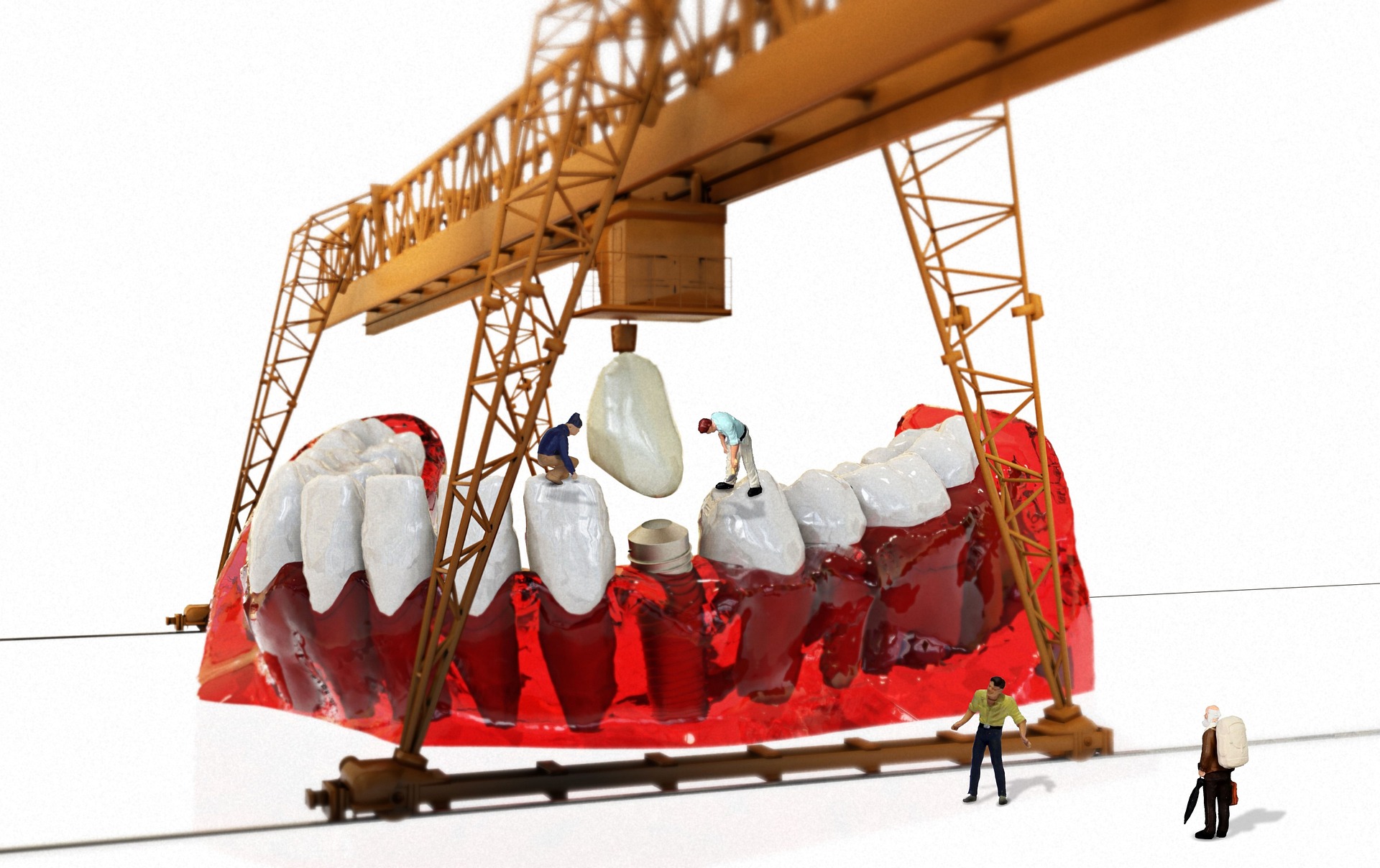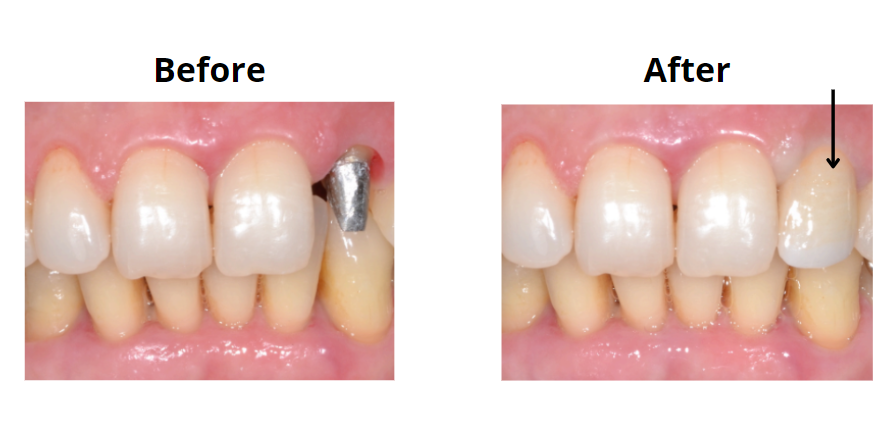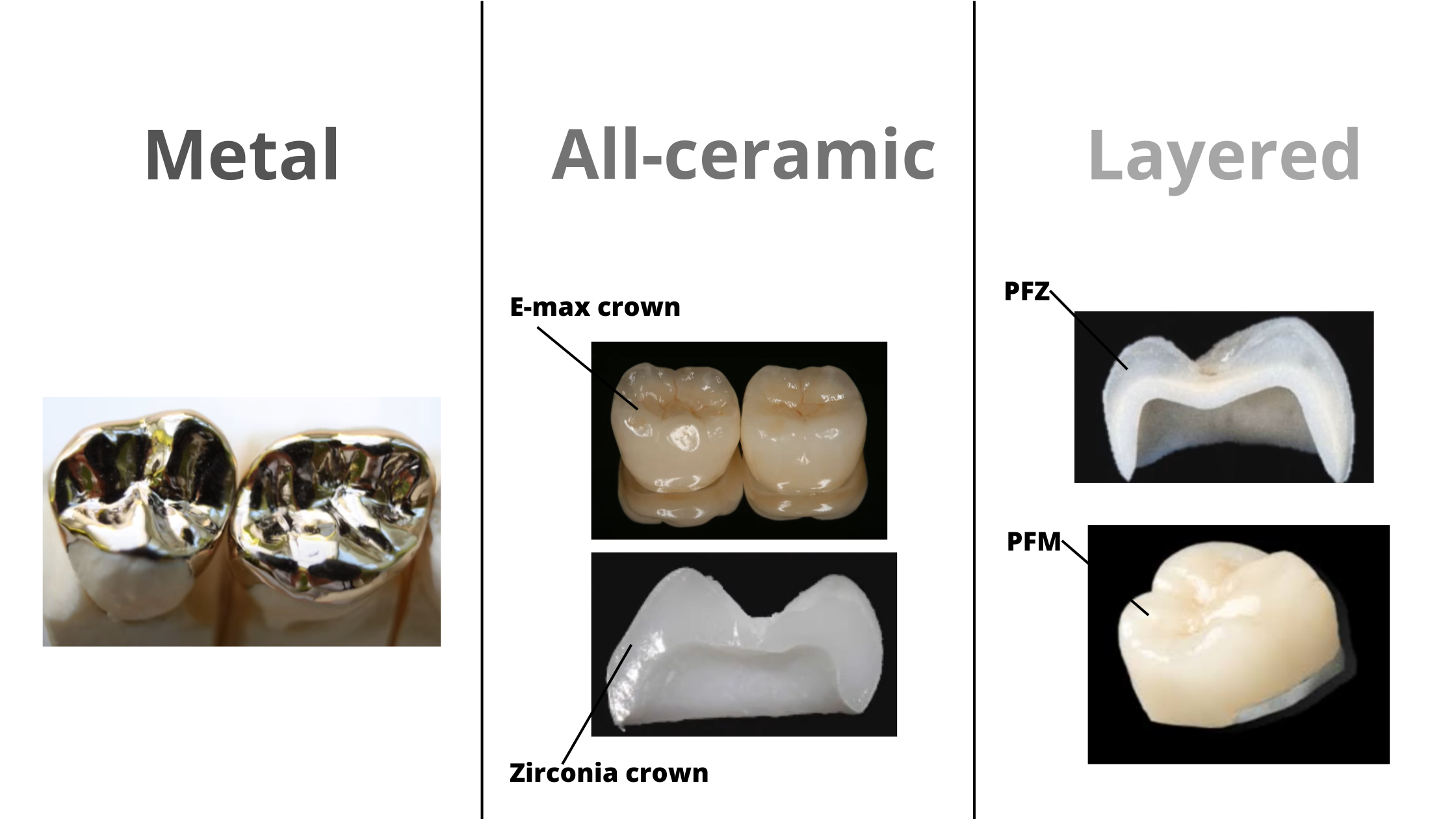What types of dental crowns are best for you?
 Dental crowns are protective caps that cover the entire visible portion of a tooth to restore its natural shape, function, and appearance. Depending on the tooth location (front or back) and your specific needs, your dentist may recommend different types of crowns.
Dental crowns are protective caps that cover the entire visible portion of a tooth to restore its natural shape, function, and appearance. Depending on the tooth location (front or back) and your specific needs, your dentist may recommend different types of crowns.
For example, front teeth typically require a cosmetic material to ensure a natural and seamless appearance. On the other hand, back teeth need a durable and resilient material to withstand the pressure of chewing.
In this article, we will explore the various types of dental crowns available and help you determine which option is best suited for your unique situation.
When is a dental crown the best solution?
Dental crowns are not the first option to restore damaged teeth. This is because the tooth first needs to be trimmed for the crown to fit. Since dental crowns cover the entire tooth surface, they require a more invasive preparation.For this reason, your dentist will always first consider a less invasive option with the best aesthetic outcome. Among them are teeth whitening, composite filling, and veneers.
However, sometimes after a thorough examination, the only remaining solution is a dental crown. Among these situations:
- Severely damaged tooth.
- Deep tooth stains.
- Cracked tooth.
- Malpositioned tooth.
- After a root canal.
How are dental crowns made?
The dental crowns can be made of one or two layers.The crown with one layer requires only one type of material. This is the case for metal, monolithic zirconia, and e-max crowns. They also require minimal tooth preparation, making them the most conservative.
The two-layer crowns are made of two materials.
The first layer is the hard substructure. It can be made of metal or zirconia.
The second layer covers the substructure with a cosmetic material, usually feldspathic porcelain.
Depending on the material used, two-layer crowns can be called porcelain fused to metal (PFM) or porcelain fused to zirconia (PfZ).
Two-layer crowns are the most invasive because they require more tooth trimming for two different materials to fit.
Dental crown types for the front teeth
 The different types of dental crowns differ by the material and technique used. Which one to choose depends on many factors, including the tooth involved.
The different types of dental crowns differ by the material and technique used. Which one to choose depends on many factors, including the tooth involved.
The front teeth are those visible when you smile or talk. They include the incisors, the canines, and partially the premolars.
When crowning these teeth, the material used should appear as natural as possible. To do so, it must match the color of the teeth and allow light to pass through, a specific property of the natural enamel (the outermost tooth layer). This property is known as translucency.
The material known to have these characteristics is porcelain.
Porcelain dental crowns are the most aesthetically pleasing and can go unnoticed. Therefore, they are the most appropriate for front teeth.
The crown types designed for front teeth include:
1. Feldspathic porcelain crowns:
Porcelain is a ceramic material composed chemically of two phases: glassy and crystalline.The glassy phase gives the porcelain a very natural and translucent appearance. As for the crystalline phase, it increases hardness and strength but at the cost of optical properties.
We will see later that the preponderance of one phase over the other will determine the type of ceramic and its best use.
Feldspathic porcelain crowns are the most aesthetic because of the preponderance of the glassy phase. But they are also very fragile due to the lack of the crystalline phase.
They are mainly used to coat the substructure part of crowns (PFZ and PFM), restore teeth under low pressure, and make dental veneers.
2. E-max crowns:
E-max ceramic is porcelain reinforced with crystals (lithium disilicate).It combines the natural life-like appearance of feldspathic porcelain (translucency and shade of natural teeth) with greater strength and durability.
E-max is so aesthetically pleasing that it does not need an outer cosmetic layer. Therefore, it can be used alone as a one-layer crown system, requiring less invasive tooth preparation. It is one of the best options for front teeth crowns.
E-max ceramic can also be used for various restorations such as veneers, Inlays, and Onlays.
It is biocompatible in the mouth (does not cause allergic reactions), tissue-preserving (requires less invasive preparation), and has a wear pattern similar to natural enamel.
3. Translucent zirconia crown:
Zirconia crowns are made from a very durable type of white ceramic material. It contains only the crystalline phase, which makes it more resistant and solid but less aesthetic.Unlike natural teeth, traditional zirconia crowns are opaque, meaning they do not transmit light. This makes them very noticeable in the mouth.
To overcome this issue, a translucent/highly-translucent zirconia material is now available. Its optical properties are improved, allowing it to blend in well with natural front teeth.
It is less solid than traditional zirconia but still better than other dental ceramics (feldspathic and e-max).
Highly translucent zirconia is biocompatible and can be fabricated in a single thin layer, preserving more dental tissue.
4. Porcelain fused to zirconia crown (PFZ):
Porcelain fused to zirconia (PFZ) involves layering a less aesthetic zirconia substructure with more cosmetic porcelain material.This type of crown is less resistant than a full zirconia crown, but its optical properties are closer to the natural tooth.
Since it is composed of two different layers, PFZ requires a more invasive dental preparation.
In addition, due to the opacity of the zirconia substructure, PFZ will never look as natural as other translucent ceramic systems such as e-max and feldspathic porcelain.
Therefore, PFZ is not always the first option for crowning front teeth.
5. Porcelain fused to metal (PFM):
It involves the same process as PFZ, except that the substructure is made of metal instead of zirconia.It is an option that comes after the PFZ and can restore both front and back teeth.
The metal gives them strength, while the porcelain makes them look attractive.
However, PFM is still not the best choice for front teeth. The reason is that these crowns are opaque, which gives them an unnatural look. In addition, the metal substructure can sometimes be visible near the gum line when you smile.
Like PMZ, PFM requires a significant reduction of the tooth. Other risks associated with this type of crown are:
- Fracture of the porcelain layer.
- Wear of the opposing teeth, as the enamel is softer than the material used.
- Allergic reactions to metal.
Dental crown types for back teeth
 Unlike the front teeth, the back teeth are not visible when you smile. How the crowns look is not so important, but their hardness and strength do.
Unlike the front teeth, the back teeth are not visible when you smile. How the crowns look is not so important, but their hardness and strength do.
Given the forces these teeth receive, crowns require strong materials to support them. Among these, we find metals and hard ceramics with a higher crystalline phase.
1. Metal crowns:
Metal crowns are composed of only one metallic material. It can be gold, titanium, nickel-chromium, or cobalt-chromium.The choice depends on the possibility of allergic reactions.
Metal crowns are the first choice for restoring the back teeth. They are strongest, more resistant, and longer lasting than ceramics.
They better preserve the dental tissue because the thickness of the metal needed to make the crown is minimal.
They are also less abrasive to opposing teeth than ceramic crowns. Therefore, they are the best solution for those who grind their teeth.
Their only drawback is that they are aesthetically unattractive. This is why they are recommended for back teeth that are not visible. Some people also report a metallic taste in the mouth.
2. Zirconia crown:
Zirconia is the hardest and strongest type of ceramic. The most used for posterior teeth is the full-zirconia crown, which is made entirely of zirconia.After the metallic crown, the zirconia crown is the second choice for back teeth, especially if you refuse metal in your mouth.
In addition to providing the necessary strength in these chewing areas, it solves all the problems associated with metal crowns. Thus, it eliminates the risk of allergic reactions, metal visibility, and unpleasant taste.
Their only problem is that they tend to wear away the enamel on the opposite teeth because they are harder. Therefore, if you grind or clench your teeth, this may not be the right choice.
3. E-max crown:
E-max crowns are very esthetic but more fragile than metal and zirconia crowns. E-max crowns can only be an option for back teeth if your bite is right and your molars are not under excessive pressure.4. Two-layer system crowns: PFZ and PFM:
PFM and PFZ can also restore the back teeth. Their inner layer is strong, but the coating consists of cosmetic porcelain, which is weaker. As a result, there is a higher risk of crown fracture, especially in the case of teeth grinding.The two-layer system crowns in the posterior teeth require a more invasive tooth preparation. Therefore, they are less preserving of the dental tissues.
The PFZ and PFM crowns are a possible option for back teeth if only there is enough space for both materials to fit and in the absence of excessive force that can damage the outer layer of the crown.
Why do you need a temporary crown in the meantime?
After tooth preparation, your dentist will take an impression, which will be sent to the laboratory to prepare your final crown. In the meantime, he will place a temporary crown.Usually, the temporary crowns are made of a tooth-colored material: resin. They are also known as all-resin crowns.
The placement of a temporary crown after tooth reshaping is important. It allows to:
- Restore your smile and the appearance of your face, especially when it concerns your front teeth.
- Restore oral functions, including chewing, swallowing, and phonation.
- Protect the tooth underlying structures, namely the dentin and the pulp.
- Protect the gum and guide tissue healing after dental preparation.
- Anticipate the final results to assess the need for an adjustment.
- Maintain the proper spacing between the teeth for the final crown to fit.
Dental crowns with computer-assisted technology
Today, some computerized systems, such as CEREC, allow you to receive your final crown on the same day. This new technology is called computer-aided design/computer-aided manufacturing (CAD/CAM).After reshaping your tooth, instead of taking a traditional impression, your dentist will take digital images of your tooth inside your mouth with a scanning device.
Then, your dentist will create a virtual 3D model of your crown with software.
Finally, he will send the data to a machine that will mill your crown from a ceramic block.
CEREC system can also make different types of restoration, including veneers, ceramic fillings, and all-resin crowns.
How to make a dental crown last longer?
On average, dental crowns last about 10 years, but you can extend that to 15-20 years if you take the right steps.Generally, metal crowns are more long-lasting than ceramic ones, but it all depends on your habits and lifestyle. Among the factors:
- Your oral hygiene.
- Types of food and drinks you consume.
- Teeth grinding.
- The habit of biting hard objects like pens, nails, or nuts.
Here are some tips to help maximize the lifespan of your crowns:
- Brush your teeth regularly, at least twice a day with a soft bristle toothbrush. Also, clean the area between your teeth with dental floss or an interdental brush. This will help remove plaque, preventing cavities from forming around your crowns.
- Avoid biting your nail or hard object that can wear out your crowns.
- Visit your dentist regularly to check the condition of your crowns and for professional teeth cleaning if necessary.
- Use a night guard if you grind your teeth at night.